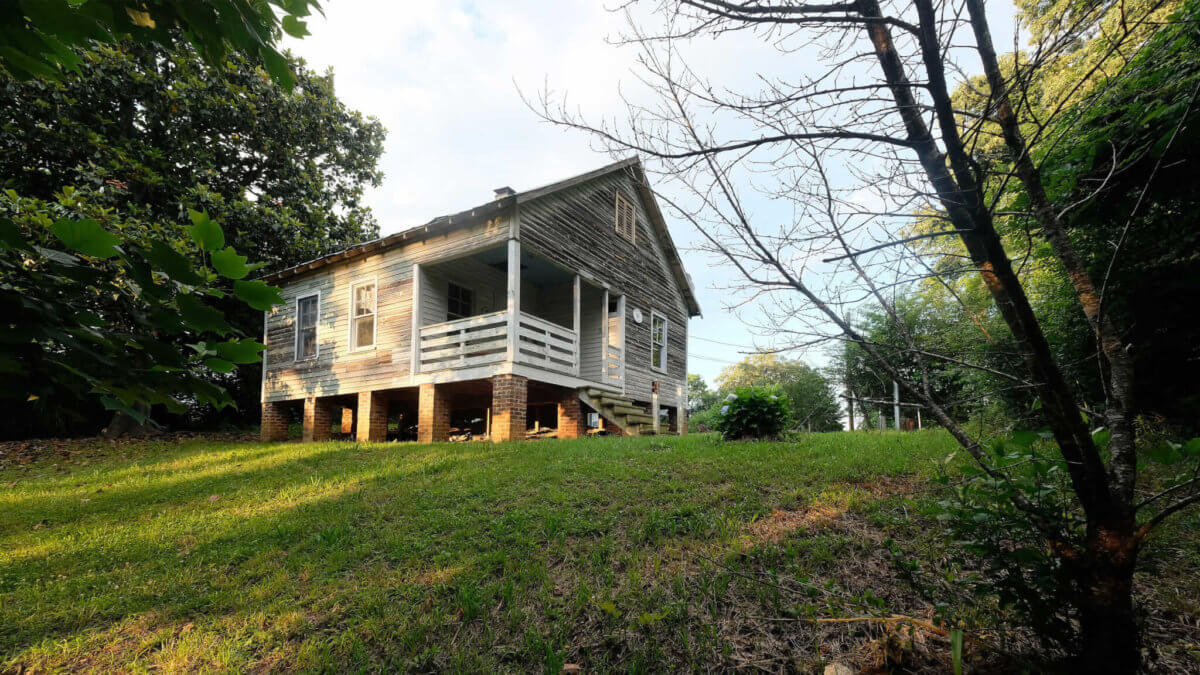
The Tryon, NC, childhood home of legendary musician Nina Simone. (Image via National Trust for Historic Preservation)
North Carolina music is eccentric, rootsy, and complicated, just like the state itself. We’ll take you to the burial places of blues and the birth of modern jazz.
North Carolina’s history in music cannot be contained in one landmark or structure. It is too eccentric for that. But if you are forced to name a place, you might start with a three-room shack in the Blue Ridge Mountains.
Eunice Waymon, who performed under the name Nina Simone, was born in this humble clapboard in 1933. The sixth of eight children in a poor Black family in the Jim Crow South, Nina learned how to play the piano here. She became a global icon, influencing pop, classical, R&B, blues, soul, and jazz in her 48-year career.
We know North Carolina. Subscribe to the free Cardinal & Pine newsletter.
Along the way, she became one of the state’s most powerful voices for civil rights. Her music felt free — free of genre, free of classification, free of inhibition — but she prospered in an era in which Black Americans and particularly Black Southerners were brutally oppressed. Her music transcended race and class, even as she spoke openly about the ways race and class impacted her life.
Nina’s music was less about place and more about voice. But there is something undeniably powerful about seeing Nina’s childhood home, which still stands today in rural Tryon, population 1,615. It was rescued by four Black artists in 2017 and today is recognized as an historic national landmark.
At Cardinal & Pine, we wanted to make a note of musical landmarks like this, places that are in many ways touchstones of North Carolina’s history as well as its culture. You cannot see Nina’s home in Tryon without imagining life for a Black family in a terribly oppressive time.
“Never gonna come back here till the day I die,” Simone sang in her song “Baltimore” in 1978. An artist who eschewed her Southern home to live on the road and, in her later years, in Europe, she might as well have been talking about North Carolina.
Here are four more of the most important musical landmarks in our state.
Hamlet, NC — The Home of John Coltrane
The jazz saxophonist John Coltrane is an imposing figure in American jazz, merging the more experimental corners of the art form with its most commercial.
His best-known albums — Blue Train, A Love Supreme, and Ascension — are unrestrained, remarkable pieces. And his stature as one of the greatest American musicians of the 20th century isn’t in doubt, even if there’s very little to make note of at the corner of Bridges Street and US 74 where he was born in tiny Hamlet.
Coltrane spent much of his childhood in High Point, but modern jazz found one of its most important figures in this little Richmond County city.
Buxton, NC — The Birth of Radio
Is any of this really possible without radio?
Radio isn’t the vanguard it used to be, but it’s how many of the greatest musical statements of the 20th century took root in the US.
It’s not often spoken of, but modest Buxton on North Carolina’s Outer Banks is the scene of the first radio broadcast of musical notes in 1902, according to the NC Arts Council. That’s where the inventor Reginald Fessenden, a one-time assistant of Thomas Edison, dispatched musical notes about 48 miles north to Roanoke Island.
Sanford to Durham, NC — The Burial Place of Blues
One of the most gifted guitarists to play the blues from North Carolina, Floyd Council, is buried in White Oak AME Zion Cemetery in Sanford, an old brick town in Lee Council. His musical partner, Blind Boy Fuller, died about 50 miles north in Durham.
Both were masters of the Piedmont Blues in the 1920s through the 1940s, influencing generations of blues musicians. In popular culture, Floyd is remembered for inspiring the name of British rockers Pink Floyd, which is a pretty lame way to remember a formative talent.
Chapel Hill, NC — DIY Rock
The only musicians still active on this list, Superchunk can already claim an impressive legacy.
Superchunk launched in the college town of Chapel Hill. These days, Chapel Hill is more of a bustling condo destination. But head down West Franklin Street in Carrboro and you’ll find of the plenty of the spunky, DIY attitude that made Superchunk synonymous with indie rock in the 1990s.
Now in their fourth decade, they’ve pulled off the complicated task of growing into alt-rock elders while somehow retaining viability with critics. The band’s co-founders Mac McCaughan and Laura Ballance are also behind Merge Records, one of the more influential indie rock labels of the last few decades.
Politics

Trump says he’s pro-worker. His record says otherwise.
During his time on the campaign trail, Donald Trump has sought to refashion his record and image as being a pro-worker candidate—one that wants to...

Biden announces new action to address gun sale loopholes
The Biden administration on Thursday announced new action to crack down on the sale of firearms without background checks and prevent the illegal...
Local News

The zodiac signs of 12 iconic women offer insight into their historic accomplishments
Zodiac signs can tell you a lot about someone’s personality. Whether they’re an earth, water, air, or fire sign, these 12 categories (which are...

VIDEO: Two men rescued off Beaufort, NC
https://www.tiktok.com/@cardinalandpine/video/7353300192906562859?lang=en WATCH: We love our Coasties in NC! ⚓️ When a boat ran aground off of...





